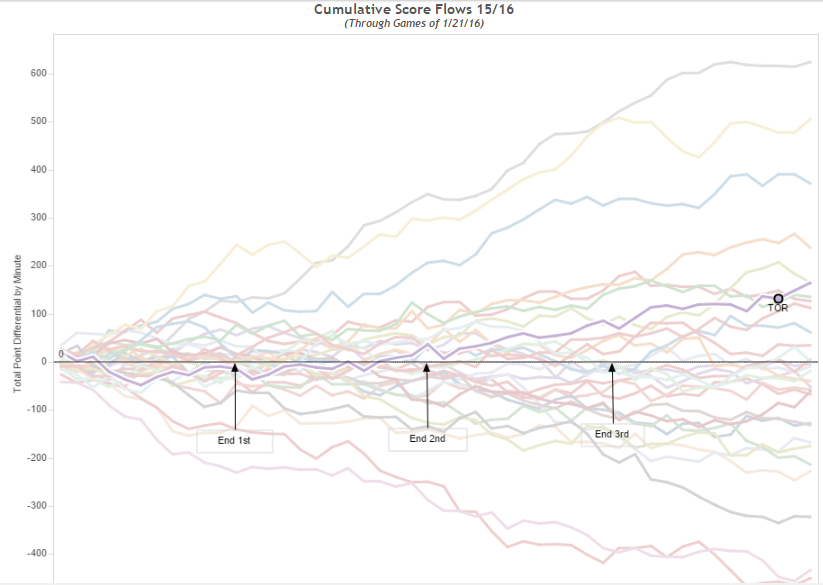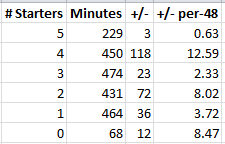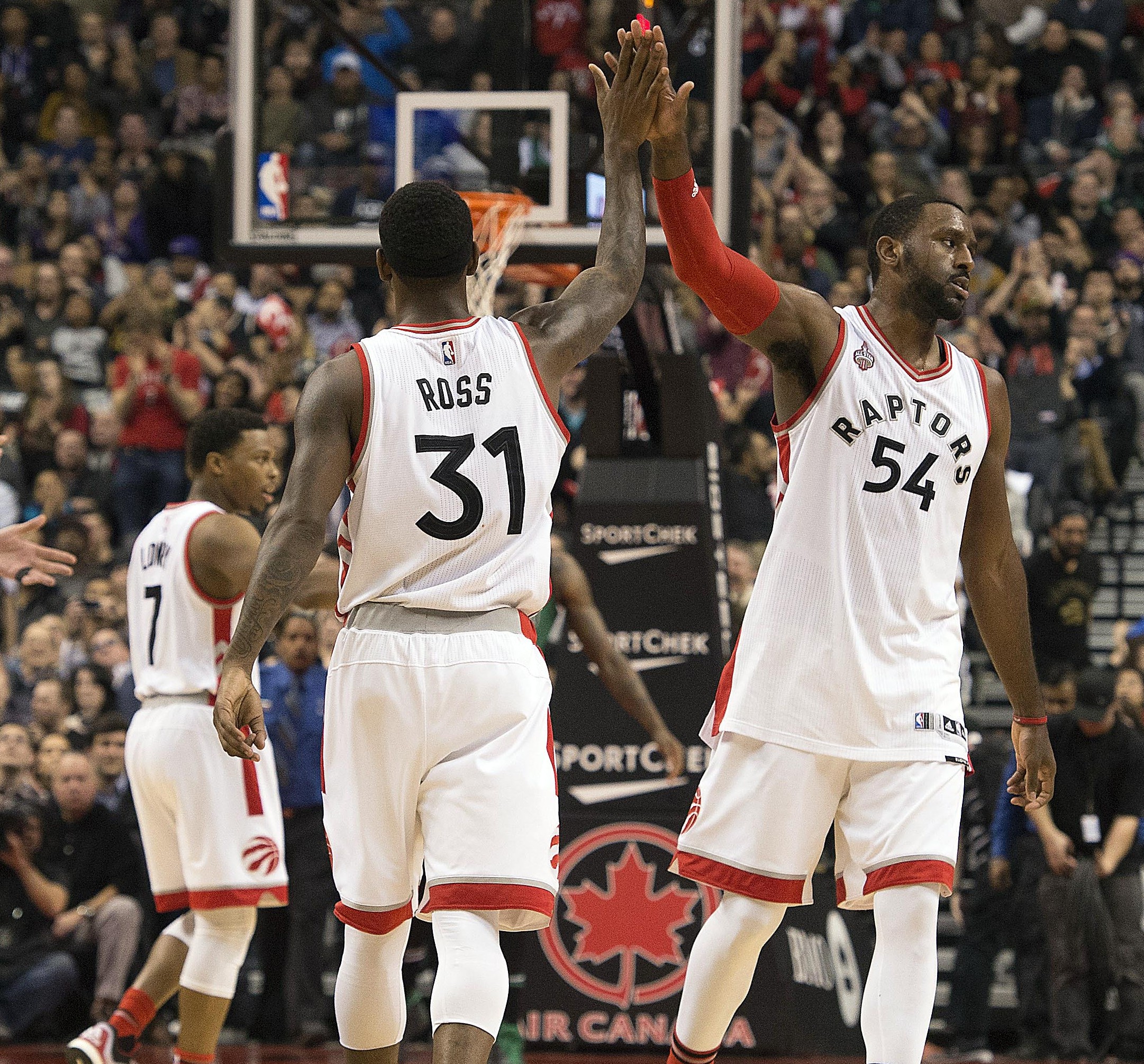One of the largest concerns facing the Toronto Raptors entering the season was depth.
While the team’s roster improved, particularly on the defensive end, a commitment to five long-term projects on the 15-man roster, none of whom could reasonably be penciled in for much playing time initially, threatened to render the team quite thin. That was particularly true at small forward and center, where there didn’t appear to be great contingencies behind DeMarre Carroll and Jonas Valanciunas. Further, the team’s roster is structured in such a way that finding workable trades to add depth is difficult. Depth, particularly bench scoring, was the primary reason I was more pessimistic than most (44-45 wins) entering the year (along with thinking chemistry would be a longer-term achievement, not the instant success it’s mostly been).
The Raptors have blown past my preseason expectations. Part of that is because the defense came together much more quickly than I anticipated, but the bench has also held up better than I expected. Valanciunas missed 17 games and the team played fine with Bismack Biyombo and smaller units succeeding. Carroll’s missed 21 games and the team’s patchwork wing rotation and return to more traditional two-big lineups late in games helped stem the tide.
My concerns weren’t off base, really. The Raptors remain incredibly thin, and save for the occasional one- or two-game spark, the five players at the end of the roster have contributed little. The team is still thin at the three and five, and the injuries have forced them to shorten the rotation to nine, sometimes even eight, players. DeMar DeRozan and Kyle Lowry rank fifth and sixth, respectively, in the NBA in total minutes played, a major concern that exists in part because of the lack of depth.
What’s more, the Raptors rank 27th in the NBA in bench scoring at just 27.3 points per-game on a 53.5 true-shooting percentage (in other words, they’re not scoring less more efficiently).
Looking strictly at that stat would do the Raptors’ reserves a woeful disservice.
The bench is playing quite well. That statement may be cause for some disagreement due to how inconsistent the individual players have played, but even without diving further, it would take quite a leap of faith in the singular abilities of Lowry and DeRozan to believe that the Raptors are 29-15 despite major injuries without strong production from the bench. It would also be wrong, because again, the bench has played quite well.
Yes, Terrence Ross started the season remarkably cold and remains an occasionally frustrating and inconsistent player. He’s also really picked up his defense and, since being re-branded as T.J. Ross on Dec. 7, is averaging 10.8 points on 48.4-percent shooting and canning 43 percent of his 3-point attempts.
The shooting struggles of Patrick Patterson persisted even longer, leading to confidence issues and some poor shot selection, a troubling continuing of a trend that began at the midway point of the 2014-15 season. He’s now shooting 44.7 percent on threes over his last 11 games. Perhaps more important to the team’s play through his struggles, he’s consistently helped set a tone with toughness off the bench, turning in what’s convincingly been the best defensive season of his career so far.
The Biyombo truthers will suggest he’s been the sole reason for the defensive turnaround, and while that’s an overstatement, he filled in admirably in over-stretched minutes as a starter and gives a plainly obvious boost to the defense when he checks in. He’s a drain on the offense despite setting terrific screens, and that’s something Cory Joseph has had trouble navigating, but he’s also a terrific offensive rebounder and he’s finished much better of late after a shaky start to the season around the rim.
Joseph, meanwhile, has been a god-send for Lowry, letting him work off the ball as a scorer for stretches on offense and giving him a reprieve on the defensive end. The Biyombo pick-and-roll pairing has been a tough one for Joseph, who will occasionally resort to over-dribbling or resetting the same action multiple times to find space, but he’s a willing creater for Ross and Patterson, he’s able to funk his way to tough layups with speed and direction changes, and with only one or two exceptions, he’s been terrific on the defensive end on a nightly basis.
James Johnson doesn’t really play off the bench – he’s averaging 23.1 minutes as a starter and 9.8 with seven DNP-CDs as a reserve – but when he does, he adds a necessary element of secondary ball-handling and can create some chaos, good and bad, at both ends. He’s a bit of a matchup play the way Dwane Casey utilizes him, though that doesn’t serve to detract from what’s been a solid, if unspectacular, job filling in as a starter for Carroll.
To a man, the Raptors’ second unit has played well, at least since the beginning of December. The bench scoring number is weak because the Raptors’ don’t use a deep rotation, because Lowry and DeRozan carry such a weighty scoring load, and because Casey does a good job making sure one of those two is helping prop up the second unit.
As a result, despite starting slow too often, the Raptors have been able to make gains as both teams begin to go to their benches late in the first quarter. This graph from Nylon Calculus charts a team’s point differential over the course of the game, and the Raptors make sizable gains from the 6-to-3 minute mark of the first quarter, over the entire back half of the second quarter, and late in third quarters, before finishing strong.
Here’s another way of looking at it, which shows that the Raptors don’t start particularly well for a good team but really begin to outplay teams through the course of games.

Part of the late-quarter successes are due to the Raptors spending an above-average amount of time in the bonus (they rank 10th at 27.2 percent of possessions in the bonus, per Nylon Calculus, and score 5.1 points per-100 possessions more in those situations) while keeping opponents out of it (fourth at 21.3 percent, with no noticeable change to the defense in those scenarios).
That impact alone can’t explain the game-flow. How does that line up with the team’s substitution pattern?
Casey generally plays DeRozan the entire first quarter and subs Lowry out with about three minutes left. He’ll go to Patterson early, just past the midway point, then bring in Ross, and later, Joseph and Biyombo, usually together. He’s trying to get all nine guys minutes early on, shifting bench guys in one or two at a time as the game dictates. He’ll then go Lowry-Joseph for a long stretch of second while DeRozan sits, then return to a predominantly starter-heavy group to close the half (sometimes Lowry will sit late in the second, too, if the lead allows). The third and early fourth work much the same way, though Casey will occasionally roll the dice with an all-bench group to close the third (tougher without Carroll). To close, he’s shown some flexibility based on the game flow, but Patterson is entrenched as almost a full-time closer with Carroll on the shelf and the team’s preferred (small) closing lineup unavailable. Ross and Joseph often see a lot of fourth, too, while Biyombo plays early and is then rendered a platoon player for defensive purposes if the game’s tight.
Given where the Raptors are making gains and how well the team’s played with two or three, or even four (with Lowry) reserves, the Raptors’ bench players deserve credit. Teams are worse the more reserves they have on the floor, and the Raptors have been able to prevent that slippage.

(Note: For the purposes of this table, Johnson and Biyombo are considered reserves, even for games they started. They’re “bench players” for this team, and we care about the particular five-man iterations, not just the start/reserve designation.)
Even if their playing time is sheltered (Patterson, Joseph, and Ross all play against roughly 2.5 opposing starters on average) and they’re being staggered with starters, they’re playing well. You wouldn’t want them doing it on their own, anyway, because all-bench units league-wide struggle, and the Raptors would be no different (the zero-starter number above is a lot of garbage time).
Opposing bench units are scoring fewer points against the Raptors than any other team (30.1), and they’re doing so on an inefficient 49.9 true-shooting percentage, which has really helped make up for the lack of counting stats from the Raptors’ own reserves. They’re a very effective defensive group, which has helped make up for the occasional offensive struggle when Lowry sits.
That offensive dip is a bit of a concern moving forward, considering Casey would be well-served to get Lowry more rest (part of that is on the team to put opponents away earlier). Lowry and four reserves have outscored opponents by 25.3 points per-48 minutes, a ludicrous mark even if it’s coming feasting on opposing bench mobs. DeRozan propping up those same groups has helped the Raptors hold serve, still a desirable outcome with four bench players, but if I were Casey (I’m not, despite what some commenters have suggested), I’d try to tether Valanciunas to DeRozan when Lowry sits. Lowry’s really helped negate any drain Biyombo has on the offense, and the Valanciunas-DeRozan pairing has been great offensively in a small sample when Lowry sits.
In any case, the four primary bench players (and Johnson) deserve a world of credit for their performance so far. Nobody in that group is a player without flaws, of course, which is why they’re bench players. But to a man, the group is defending well, the shooters have started hitting shots regularly, and they’ve all found a chemistry when playing together or alongside several starters.
.@Raptors bench was 19/33 on FG’s for 51 points in #LACatTOR. Shot chart: pic.twitter.com/mLfUY5I0DL
— NBA.com/Stats (@nbastats) January 25, 2016
Usually, the impact will be much more muted than it was Sunday against the Clippers. Just don’t look at the bench potentially being outscored in a game and think this group isn’t doing their job. They’ve been a major factor in the team playing well through injuries and in the second-longest winning streak in franchise history.
—
Semi-related side-note: The longest winning streak in team history, the nine-game playoff push without Vince Carter in 2001-02, came thanks in large part to strong bench play (Mo-Pete was starting for Carter alongside the Williamses, AD, and Montross).





